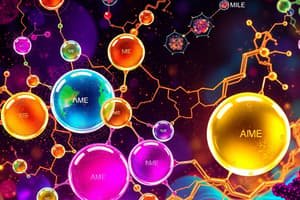Podcast
Questions and Answers
What is the most important chemical property of amines?
What is the most important chemical property of amines?
- Basicity (correct)
- Reactivity with acids
- Ability to form salts
- Solubility in water
Which type of amine has nitrogen bonded to two hydrogen atoms and one carbon group?
Which type of amine has nitrogen bonded to two hydrogen atoms and one carbon group?
- Secondary amine
- Quaternary amine
- Tertiary amine
- Primary amine (correct)
In which type of amine is nitrogen bonded to three carbon groups?
In which type of amine is nitrogen bonded to three carbon groups?
- Primary amine
- Tertiary amine (correct)
- Secondary amine
- None of the above
What distinguishes an aromatic amine from an aliphatic amine?
What distinguishes an aromatic amine from an aliphatic amine?
How are amines classified into primary, secondary, and tertiary?
How are amines classified into primary, secondary, and tertiary?
Which compound serves as a building block for the amine bases of DNA and RNA?
Which compound serves as a building block for the amine bases of DNA and RNA?
What type of amine is formed when nitrogen is part of an aliphatic ring?
What type of amine is formed when nitrogen is part of an aliphatic ring?
How are IUPAC names for aliphatic amines formed?
How are IUPAC names for aliphatic amines formed?
How do the solubility properties of amines compare to hydrocarbons of similar molecular weight?
How do the solubility properties of amines compare to hydrocarbons of similar molecular weight?
Which statement best describes the basicity of amines?
Which statement best describes the basicity of amines?
Which phenomenon contributes to the distinct odors of low-molecular-weight amines?
Which phenomenon contributes to the distinct odors of low-molecular-weight amines?
What tends to happen to the solubility of amines as their molecular weight increases?
What tends to happen to the solubility of amines as their molecular weight increases?
Which type of amines are generally stronger bases?
Which type of amines are generally stronger bases?
What happens when amines react with strong acids?
What happens when amines react with strong acids?
Which of the following is a characteristic of pyridine?
Which of the following is a characteristic of pyridine?
Which of the following amines is a strong poison?
Which of the following amines is a strong poison?
Which of these compounds is NOT described as an alkaloid?
Which of these compounds is NOT described as an alkaloid?
What is the role of amines in drug solubility?
What is the role of amines in drug solubility?
Flashcards
Amines
Amines
Organic compounds containing nitrogen bonded to carbon atoms.
Primary amine
Primary amine
An amine in which the nitrogen atom is bonded to one carbon group and two hydrogen atoms.
Secondary amine
Secondary amine
An amine in which the nitrogen atom is bonded to two carbon groups and one hydrogen atom.
Tertiary amine
Tertiary amine
Signup and view all the flashcards
Aliphatic amine
Aliphatic amine
Signup and view all the flashcards
Aromatic amine
Aromatic amine
Signup and view all the flashcards
Heterocyclic amine
Heterocyclic amine
Signup and view all the flashcards
Heterocyclic aromatic amines
Heterocyclic aromatic amines
Signup and view all the flashcards
Amines and Acid Reactions
Amines and Acid Reactions
Signup and view all the flashcards
Amines as Bases
Amines as Bases
Signup and view all the flashcards
Ammonium Salt Formation
Ammonium Salt Formation
Signup and view all the flashcards
Solubility of Amines
Solubility of Amines
Signup and view all the flashcards
Aliphatic vs. Aromatic Amines
Aliphatic vs. Aromatic Amines
Signup and view all the flashcards
Stronger Base in a Pair
Stronger Base in a Pair
Signup and view all the flashcards
Alkaloids - What are they?
Alkaloids - What are they?
Signup and view all the flashcards
Examples of Alkaloids
Examples of Alkaloids
Signup and view all the flashcards
Naming Amines (Simple)
Naming Amines (Simple)
Signup and view all the flashcards
Naming Amines (Complex)
Naming Amines (Complex)
Signup and view all the flashcards
Why Are Amines Basic?
Why Are Amines Basic?
Signup and view all the flashcards
Aliphatic vs. Aromatic Basicity
Aliphatic vs. Aromatic Basicity
Signup and view all the flashcards
Amines and Water
Amines and Water
Signup and view all the flashcards
Physical Properties of Amines
Physical Properties of Amines
Signup and view all the flashcards
Study Notes
Chapter 16: Amines
- Amines are organic compounds containing nitrogen.
- Carbon, hydrogen, and oxygen are the three most common elements in organic compounds.
- Nitrogen is the fourth most common element found in organic compounds.
- Amines are widely distributed in biological systems.
- The most important chemical property of amines is their basicity.
- The functional group of an amine is an amino group (NH2, RNH2, R2NH, or R3N) – a nitrogen atom bonded to one, two, or three carbon atoms.
Amine Classification
- Primary (1°) amines: Nitrogen bonded to two hydrogens and one carbon group.
- Secondary (2°) amines: Nitrogen bonded to one hydrogen and two carbon groups.
- Tertiary (3°) amines: Nitrogen bonded to three carbon groups.
Aliphatic or Aromatic Amines
- Aliphatic amines: All carbon atoms bonded to nitrogen are derived from alkyl groups.
- Aromatic amines: One or more groups bonded to nitrogen are aryl groups.
Heterocyclic Amines
- Heterocyclic aliphatic amines: Nitrogen atom is part of a saturated ring.
- Heterocyclic aromatic amines: Nitrogen atom is part of an aromatic ring.
- Heterocyclic aromatic amines include pyridine and pyrimidine, where nitrogen atoms replace carbon atoms in a benzene ring.
- Pyrimidine and purine are building blocks for amine bases in DNA and RNA.
Amine Nomenclature
-
IUPAC names for aliphatic amines: Derived like alcohols, replacing the -e in the parent alkane with -amine.
-
Location of the amino group is indicated with a number.
-
Common names for aliphatic amines: List groups bonded to nitrogen in alphabetical order, ending in -amine
-
Simplest aromatic amine: Aniline (C6H5NH2).
-
Simple derivatives of aniline are named using ortho (o), meta (m), or para (p) to locate substituents.
-
Derivatives of aniline: e.g., toluidine (methyl-substituted aniline).
-
Unsymmetrical secondary and tertiary amines: Named as N-substituted primary amines.
-
The largest group bonded to nitrogen is the parent amine. Smaller groups are prefixed with N.
Physical Properties of Amines
- Low-molecular-weight amines have sharp, penetrating odors.
- Amines are polar compounds.
- Primary and secondary amines associate through intermolecular hydrogen bonding.
- Tertiary amines do not hydrogen bond with each other.
- All classes of amines form hydrogen bonds with water and are more soluble in water than comparable hydrocarbons.
- Most low-molecular-weight amines are completely soluble in water.
- Higher-molecular-weight amines are only moderately soluble or insoluble in water.
Basicity of Amines
-
Amines are weak bases like ammonia, forming basic solutions.
-
Aliphatic amines are stronger bases than aromatic amines.
-
Aliphatic amines are stronger bases than aromatic amines.
-
All amines, regardless of solubility, react with strong acids to form water-soluble salts.
Characteristic Reactions of Amines
- Reactions with strong acids form water-soluble salts, aiding in the separation of water-insoluble amines from non-basic compounds.
- Amines accept protons (H+) and form ammonium salts.
Alkaloids
- Alkaloids are amines isolated from plants.
- They often include poisons, drugs, and addictive substances.
- Examples: Nicotine, strychnine, caffeine, morphine, codeine, heroine, quinine, cocaine, and methadone.
Studying That Suits You
Use AI to generate personalized quizzes and flashcards to suit your learning preferences.





